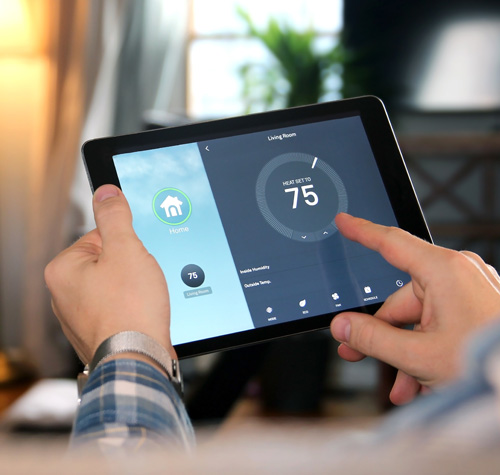Smart Controls and Functions
Depending on the type of smart boiler/system you have or have chosen to have installed there are many solutions that compromise simplistic operation with intelligent boiler control.
Below are the main controls available and a brief overview of their operation.
Room thermostat
A basic on/off control that controls the boiler by the set temperature of the room controlled by the homeowner and normally used in conjunction with a timer/programmer.
Programmer/timer
A device used to control the times you would like your heating and/or hot water to turn your boiler on.
Programmable room thermostat
A room thermostat that incorporates a timer into the same unit allowing adjustment of time and temperature from one controller.

Smart control
A device that will still use either a thermostat or programmer to control demand for heating with the added element of being able to use those features from a phone/tablet or pc, giving the user greater flexibility and internet connectivity. These devices also incorporate further advances in technology such as geofencing, weather compensation, automation, optimisation and allows multiple users. Automation is a function that allows the device to automatically control the heating system output in response to programmed demand (e.g. scheduling with temperature control) or occupancy detection. Optimisation means the device calculates how long it takes the property to reach the desired comfort level, and times the system’s operation to minimise the amount of work it must do.
Open Therm
Open Therm is a communication protocol/language that allows boilers and controls to communicate in the same language including the use of third party/non boiler manufacturers controls. It has all the features of programmable room thermostats with the added capabilities of self-learning through2 way communication giving greater control and comfort levels.
Weather Compensation
This type of control use and external sensor connected to the boiler that relays the outside temperature back to the boiler, with this information along with the set point of the internal temperature it then automatically calculates what temperature the boiler should flow at to maintain the requested indoor temperature. This technology uses an adaptive heat curve that is adjustable to suit all house types whilst keeping the boiler in condensing mode even during the coldest of days.
LOAD COMPENSATION
Load compensation is a common function in many smart controls and programmable thermostats. These devices measure the gap between what the internal temperature is and what the user wants it to be and modulates the boiler so that it only uses as much fuel as necessary to close the gap. This allows the boiler to adjust its output to maintain comfort levels and reduces the number of start-ups the boiler goes through so helps with the longevity of the boiler.
THE BENEFITS OF WEATHER COMPENSATION
To most people the phrase weather compensation will be totally alien and only a few years ago it meant very little to me or many other boiler engineers. Why this technology is not more widely used astounds me when you understand just how good this is, not just for your boiler but for comfort, efficiency, condensing, longevity, great for use with underfloor heating and is very versatile.
WEATHER COMPENSATION EXPLAINED
So how does it work? Well quite simply it uses a little outdoor sensor usually on a north facing wall to relay data about the temperature outside back to the boiler. Then it looks at the temperature you want your home to be and viola the magic happens. With both these parts of information the boiler automatically knows what temperature the boiler needs to flow at to get to and maintain your set temperature (normally 19-21 degrees) but not only that it will then automatically adjust as the temperature outside or inside alters. So, if the temperature outside rises the boiler reduces its output, and likewise if the temperature outside drops then the boiler increases its output.
This process will happen however which way you adjust the desired room temperature whilst maintaining comfort levels.
The clever part of all this is the fact the boiler is nearly always in condensing mode, maximising its efficiency and keeping you nice and comfortable whilst lowering your gas bills and carbon footprint. All boilers are not created equally so the right boiler with the right software makes a lot of difference. They use what is called a heating curve which is adjustable to allow weather compensation to be use in many different types of homes, from old draughty ones to modern, double glazed well insulated properties.
FACTORS TO TAKE INTO ACCOUNT
Radiators need to be checked for adequate output, if they are already too small then this will only highlight this further. Radiator temperatures will be quite lower than you are used to and for some people they don’t quite understand how this can be the case and still maintain room temperature. Radiators are not for drying towels, if you cover them up with washing, furniture, beds or radiator covers you lose a minimum of 50% of the output.
A clean system is so important as if your radiators are suffering with sludge build up then once again the output is massively reduced. Insulation either by means of cavity wall or loft insulation, double glazing all makes a huge difference to the amount of heat required to heat your home and maintain comfort. The outdoor sensor needs to be sited on the correct facing wall and is hardwired so a cable is required back to the boiler.
ADVANTAGES OF WEATHER COMPENSATION
- Improved levels of comfortImproved levels of efficiency
- Lower running costs
- Longer boiler lifetime
- Reduces breakdowns
- User friendly and easy to operate
- Ideal for use with underfloor heating
- Less boiler starts and longer burn times.
- Super quiet operation
- Class 4 erp energy efficiency up to 96%
- Boiler plus compliant
